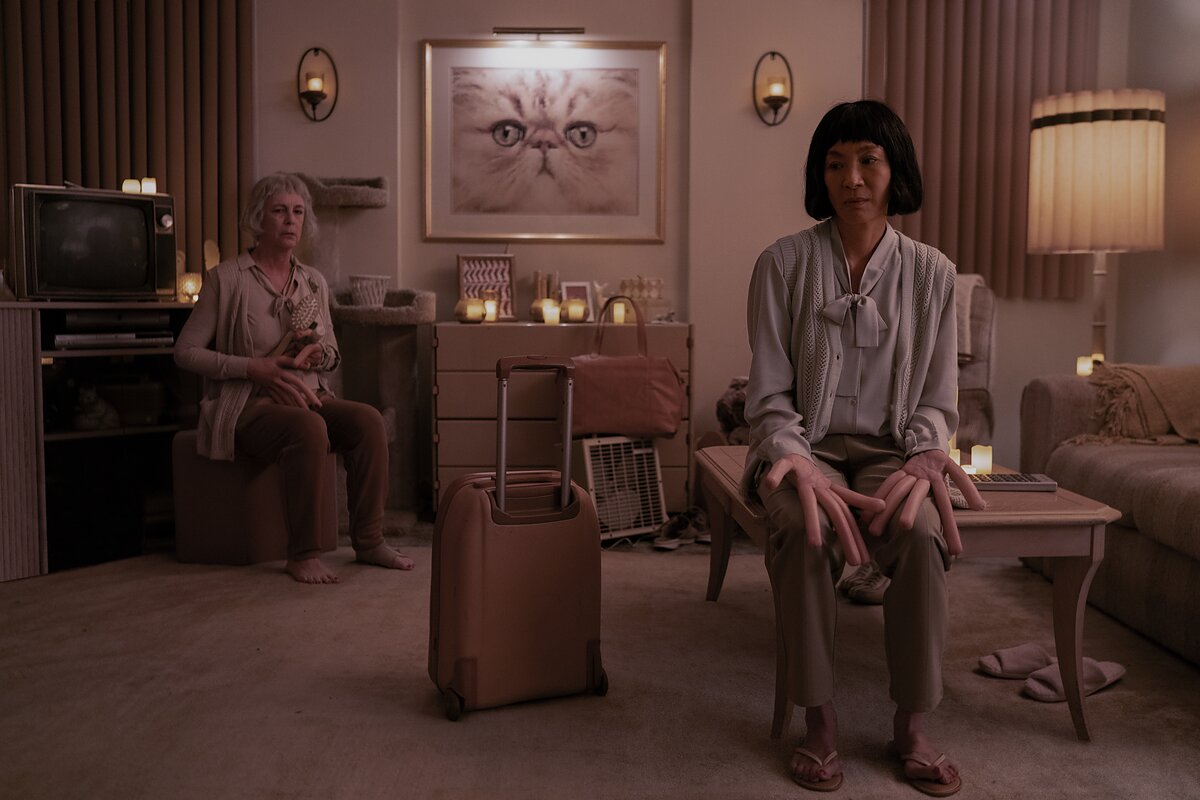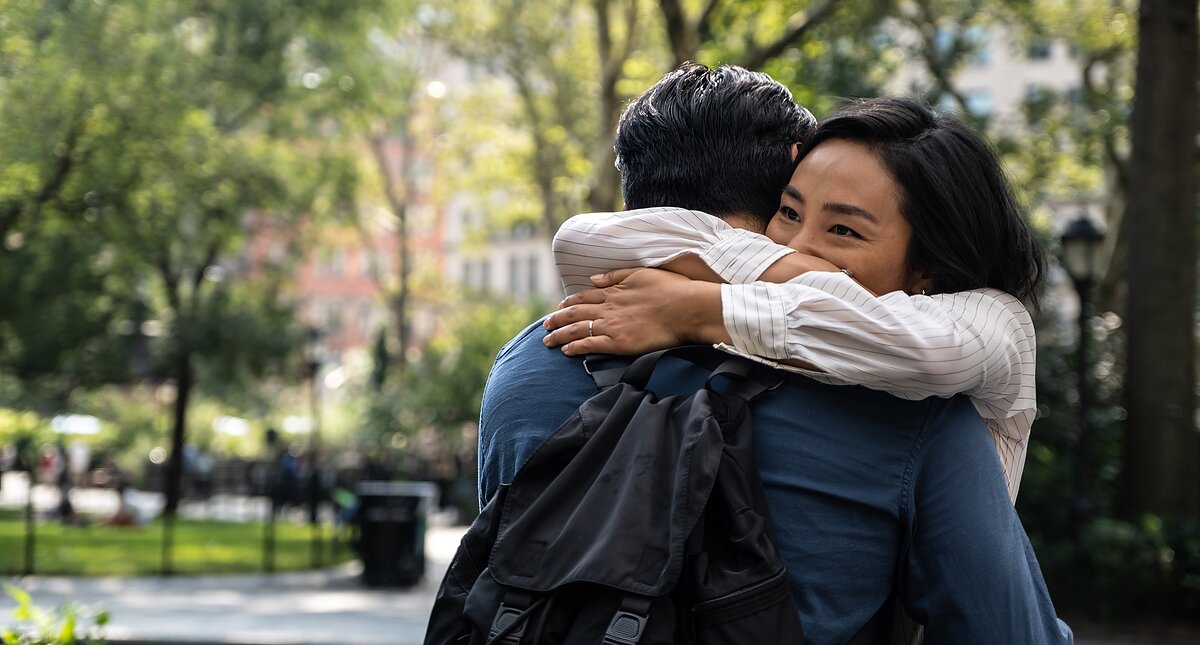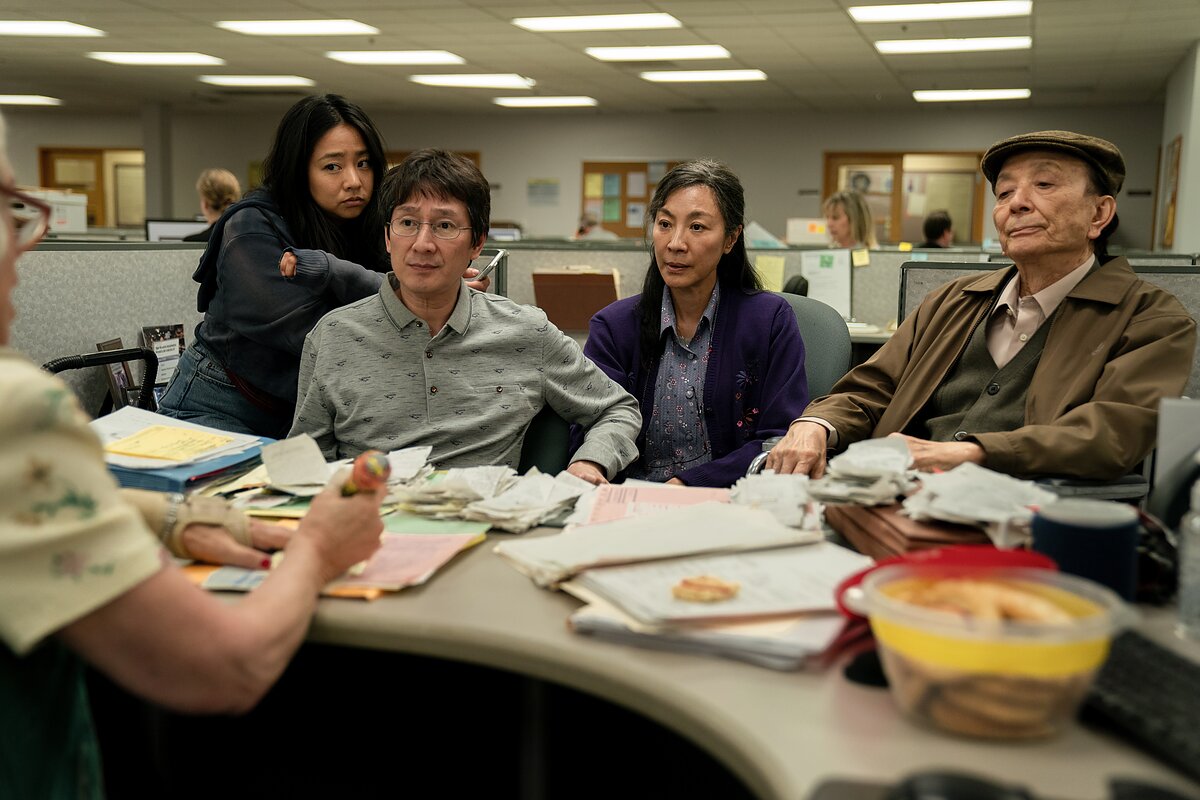Every Past Life All At Once: Alternate Realities and the Immigrant Experience
The films Past Lives (2023) and Everything Everywhere All At Once (2022) pose a quintessential question for Asian Americans and other diasporic identities—how do immigrants reconcile the lives they leave behind with their new ones? And they ask, more universally, how we all might grieve the roads not taken; the lives we don’t get to live.
In Past Lives, the decision to immigrate forecloses the possibility of other lives, no matter how alluring they might be. In Everything Everywhere All At Once, those choices only seem to be closed when in fact, they coexist in a multiverse that can be traversed with the right skills. The first is a realist film told in three understated chapters over the course of 24 years. The second is a maximalist science fiction that takes place over a single day, but also stretches from the dawn of humanity to an unnamed future where people jump across alternate realities.
Both films are distributed by A24 and break down the dichotomy between arthouse and Hollywood, between traditional narrative and experimental storytelling. Both center Asian American women who leave their home countries when they are young for economic reasons. Nora in Past Lives leaves Korea as a preteen because her artist mother and father decide to move to Canada (which Nora, in turn, leaves for New York). Evelyn in Everything leaves China as a young woman to be with her fiancé Waymond, who promises the excitement of American entrepreneurship.
The two films capture a feeling particular to immigrants of a certain age, known as the 1.5 generation, who are old enough to remember their first homes but young enough to adapt to, and even fit in their new ones. It’s different from the experience of the refugee or the exile—upheavals that often make it harder to imagine an equally contented (or difficult) life in the homeland. The moment of departure for 1.5 migrants becomes not just a demarcation of a before and after, but what is and what could have been.
This is the phenomena for which both films build a visual language, one that might be described, to borrow Cathy Park Hong’s phrase, as a “minor feeling”—so nuanced and ignored that it’s easy to pretend, individually and socially, that it isn’t there. How do you film the unruly ways memory and imagination create alternate lives? The ways they collapse decades and continents, or construct fantastic worlds then let them crumble in a blink? How do you capture the emotional wakes that follow?
Part of Evelyn’s struggle in Everything is that she and those around her ignore the immense loss of a life that could have been. These manifest in everyday details like condescending customers and the googly-eyes her husband Waymond places everywhere. She’s lost her homeland, her family, her ambition. And she’s powerless to repair that loss. Meanwhile, Nora in Past Lives moves from Korea to Canada to New York in order to build a life as a working artist whose plays are produced and who has the leisure to go on residencies. Despite her hard-won success, we sense a loneliness and longing below the surface. That feeling is strong enough that she initiates a regular Skype call with her childhood sweetheart Hae Sung across a 13-hour time difference—a displaced, double life that is more fulfilling than her “real” one.
David Eng and Shinhee Han, in their book Racial Melancholia, Racial Dissociation, use Freud’s concept of mourning and melancholia to understand their Asian American students’ struggles with depression, anxiety, and suicidality. Asian Americans must mourn our homelands, a mourning that is permanent and therefore turns, as Freud said, to melancholia. But unlike Freud, Eng and Han de-pathologize melancholia—it’s not an illness, it simply describes a condition we face.
Assimilation denies the capacity to face this melancholia: to belong, merely to survive in America means severing those lives without turning back. To retain them—those customs and ways of moving through the world—would mean standing outside American society as an “other.” There’s no room to metabolize melancholia. The importance of art, then, is to remind us of those choices; to understand the quiet, violent severing of the past.
Both films use quick cuts to traverse time and space and find the roots of their protagonists’ melancholia. In Everything, we jump between wildly different worlds to glimpse what Evelyn might have become. It’s something that we normally wouldn’t accept as viewers, yet the film brilliantly trains us in this central conceit, building until we accept absurd worlds where stones talk to each other, or where humans have evolved hot-dog hands. Here, cuts across genre and time and other universes resist melancholia. They open portals that aren’t possible in our mundane worlds, arguing for the full use of our imaginative powers.
A pivotal scene in Past Lives shows Hae Sung and Nora meeting again in New York after 24 years apart in front of a public sculpture in a verdant park. We get a quick flashback to one of the first scenes in the movie, in which the two of them as children play in another sculpture park in Seoul. It’s a deeply complicated moment: that memory was, in a sense, constructed by Nora’s mother, who wanted to give her beautiful memories before leaving Korea. The present moment is fraught with Hae Sung’s unstated intention to see Nora and create a life together—an intention that he hardly admits to himself, let alone Nora. Here, with the shocking quickness of memory, the cut shows us both the sweetness and loss of Nora’s past.
But if these films, and film in general, offer new ways to understand the sweep of space and time, it’s harder to visualize the subtle emotional pull of that distance, or to show how we face and hold the lives we can’t access.
Everything Everywhere offers a sweet if unsatisfying answer: we are living our best possible lives, and to accept that, we must accept the people around us. Once Evelyn learns to “fight” like the compassionate Waymond, once she empathizes with her cruel tax auditor, once she embraces her suicidal daughter Joy, she can settle into her life of laundry and taxes.
This resolution doesn’t quite make sense. Loving relationships certainly help us weather grief and change in life, but have they ever meant we didn’t have to face them? The conclusion is made less convincing because the critical moment of repair, when Evelyn confronts Joy outside the laundromat and determines to stay with her, is emotionally muddied. Joy isn’t asking for Evelyn to stay with her, she’s asking to live an integrated life across the multiverses and to reconcile the wildly differing expectations and pressures that tear her apart.
Still, emotional resolution between Evelyn and Joy isn’t as important as the ride we take to get there. We are treated to a fantasy tour through martial arts, Bollywood, soft-focus romance, and Wong Kar-Wai neo-noir; all the genres of film and life one could imagine. We’ve eaten at the infinite buffet so that by the end of the journey we, like Evelyn, crave a simple soup. The last scene at the IRS office suggests that Evelyn retains the power to glimpse other universes. She appears wistful for them, yet is content to stay in hers.
Past Lives offers a more direct and less glamorous resolution: you must say goodbye to your other lives to accept this one. The quiet climax of the film is given in the very first scene—we watch Nora and Hae Sung talk at a bar in Korean while Arthur, Nora’s husband, sits awkwardly to the side. We hear the voices of two people speculating on their relationship, unable to determine who is in a relationship with whom; a speculation that prophesizes the film’s central tension. By the time we revisit that moment towards the end of the film from a closer camera angle, we understand the intimate,fun, and loving relationship that might have been between Nora and Hae Sung, and the poignancy of getting to taste it.
In the film’s very last scene, the camera follows Nora and Hae Sung as they walk to meet the car that will take him back to the airport, then follows Nora on her way back home where she finally breaks down in the arms of the waiting Arthur who embraces her and makes room for her loss. The distance of the walk is not just half of a New York City block, but the distance of the intervening decades, of the 8,000 miles between New York and Seoul; it’s a final goodbye to the person who was her first and perhaps truest love. And though in retrospect it seems inevitable, and though Nora and Arthur’s relationship isn’t defined enough to tell us how much Nora might have given up had she chosen Hae Sung, it’s still a shocking experience. It’s a surprise to see a film that asks us to grieve the beautiful relationship that could have been instead of fulfilling that fantasy.
Less important than the question of which film “gets it right” is how they point to the same phenomenon through their respective truths. Together, Everything and Past Lives form a powerful dual portrait: life is both extravagant and simple. The wildest journeys are accessible to us yet it’s the quiet, painful goodbyes that ultimately matter.
Nora describes the concept of in-yun as the thousands of years and encounters it takes for two people to meet in this life; a sort of fate. A more direct translation of that Buddhist phrase would be “causes and conditions,” one of the philosophical pillars of Buddhism. The Buddha said that it is essential to acknowledge causes and conditions, to accept that each of our actions has consequences. Fate is only half of it. Yes, we are born into myriad circumstances beyond our control, but we are also fully responsible for these lives we didn’t ask for.
We often ignore or deny this responsibility because it requires us to mourn the constant what-ifs, to face the rawness and heartbreak built into the small, endless decisions that make up our lives.
But if we don’t grieve these lost possibilities, we remain in denial, a state of wishfulness or dissociation in which our choices do not matter and our fates are entirely out of our control. These are the states we find Nora and Evelyn in: Nora’s dissociation from her deeper longing, Evelyn’s denial and feeling of powerlessness. Both Nora and Evelyn ultimately go back to their lives, but they cannot truly “go back.” They are forever changed. They escape the miring anxiety and melancholy of what if by forming deeper and more honest relations to their lives. They’ve given wholehearted attention to those causes and conditions, those other possibilities, then let them go.
Migration is one of the most powerful reminders of the impermanence and mutability of life. To be a migrant is to face all the lives we are not living and cannot ever live. And to lose our language and culture and place and loved ones is true for all of us—whether it is to cross an ocean or watch our neighborhood change, to lose lovers to distance or to death. We are all migrants through this brief life.
—Ryan Lee Wong is author of the novel “Which Side Are You On.” He has written on the intersections of arts, race, and social movements. He holds an MFA in Fiction from Rutgers-Newark and served on the Board of the Jerome Foundation. He lived for two years at Ancestral Heart Zen Temple and is based in Brooklyn, where he’s the Administrative Director of Brooklyn Zen Center.





